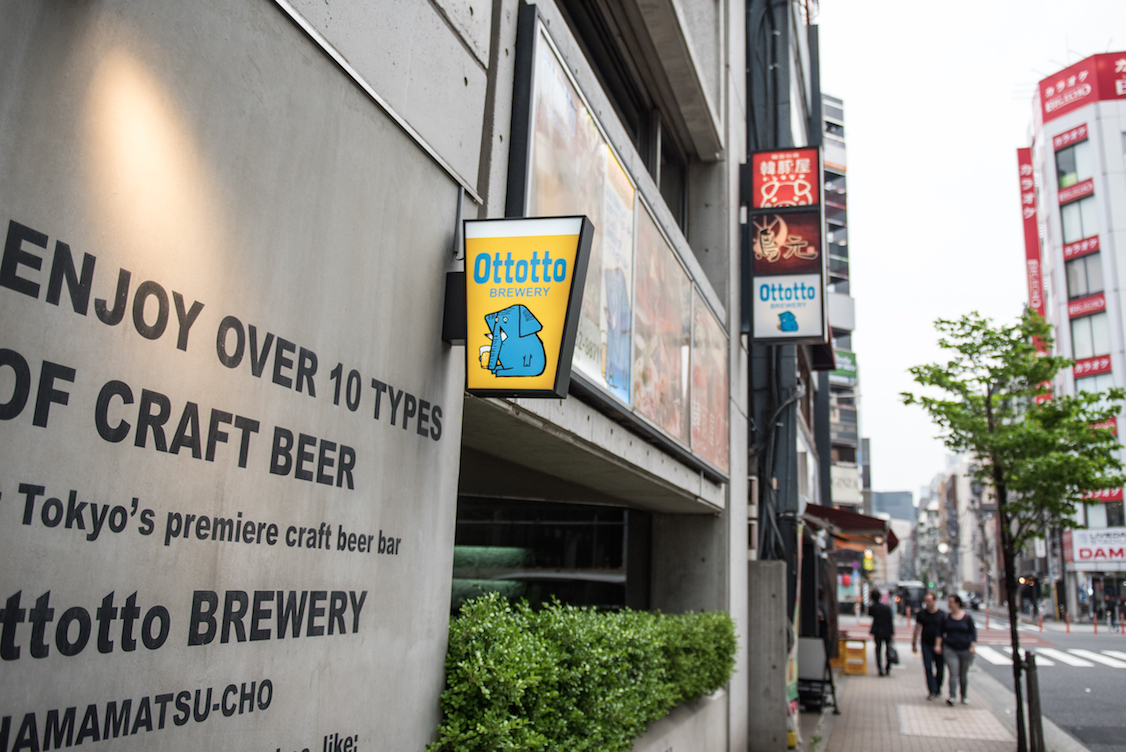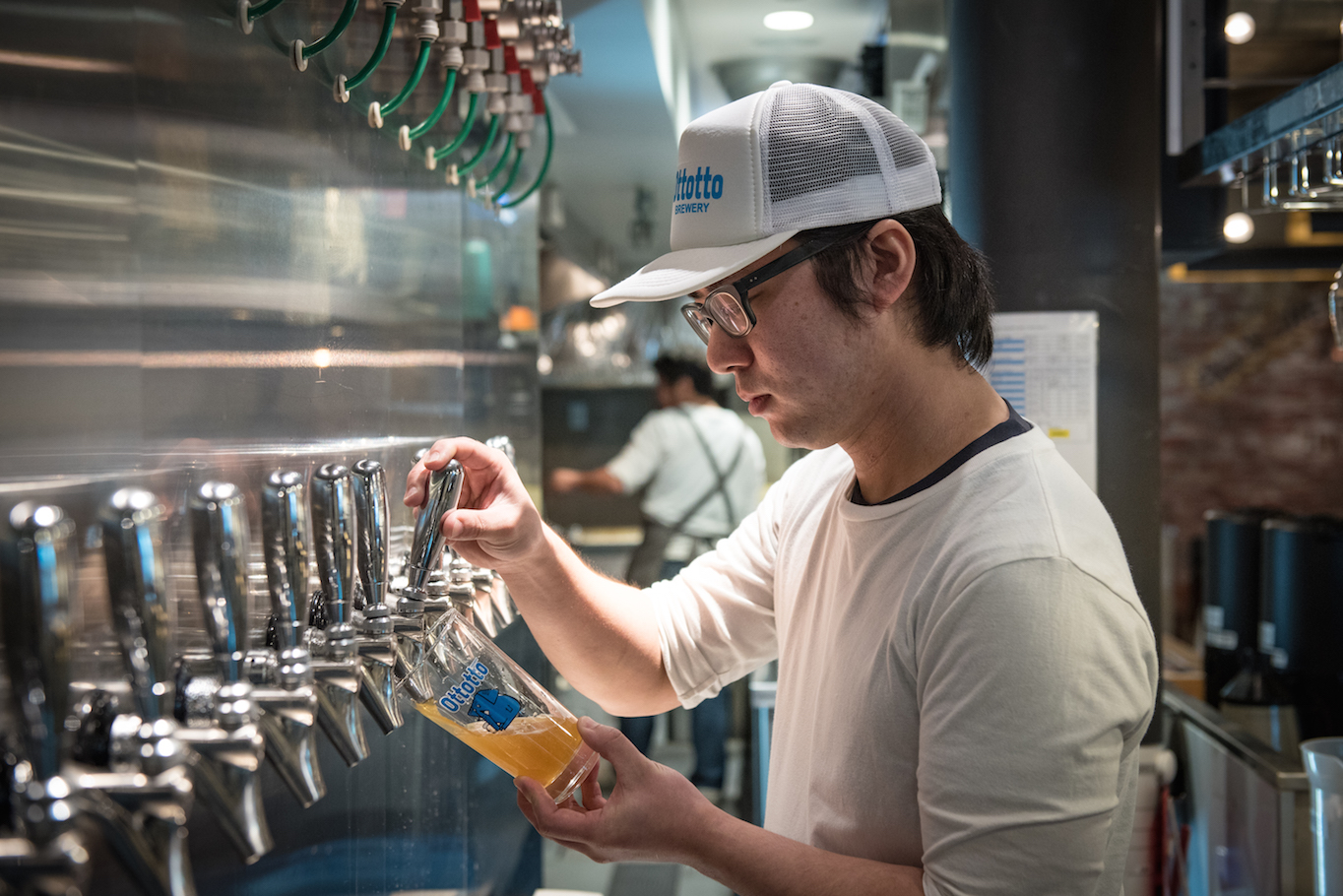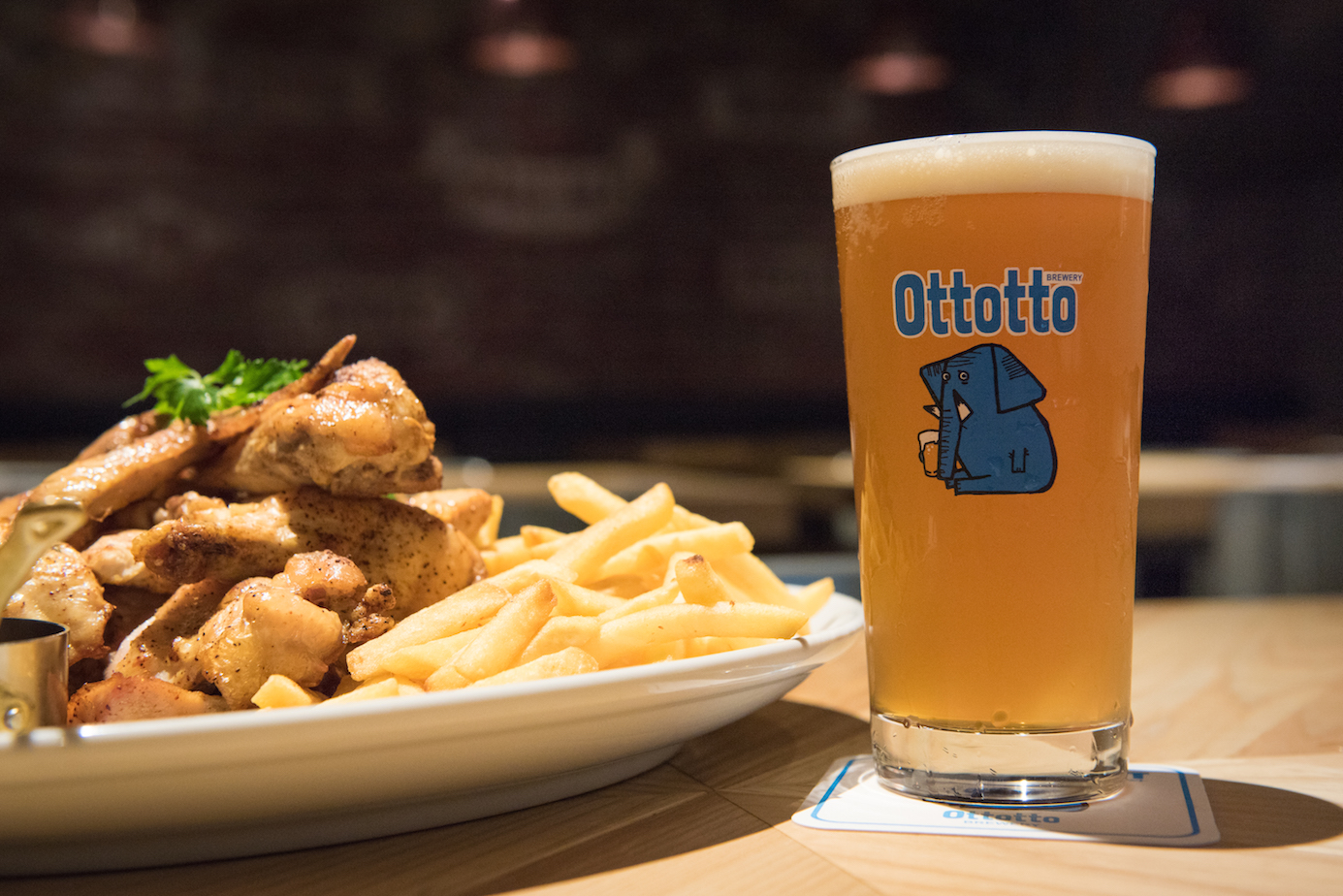
text by Chiaki Akasofu, photos by Matt Gammon
Enjoying alcohol is one of life’s pleasures. It goes without saying that having a drink in hand while passing time with colleagues, family or good friends–and then rising from your chair a little tipsy–is a good feeling. The phrase “ottotto” (Whoa, that’s enough.) that you’ll hear at times like these seems like a common refrain at Ottotto Brewing, the bustling brewpub which opened its first location in Hamamatsucho in the fall of 2017.
Ottotto Brewery’s parent company is Ramla, a restaurant corporation that mainly does business in metropolitan areas through its 52 brands and some 150 retail locations, including overseas ones in cities such as Shanghai and Los Angeles. From Japanese and Chinese to Western cuisine, Ramla draws from the culinary traditions of many countries and offers the full range of food services from dish preparation to online retail. Regardless of the operation, the company’s many assets share a common guiding principal: “Food is culture, having fun is culture.” Japan, like many other places, is not just big on craft beer, but craft products in general and that trend looks set to continue, but how does a large food-and-beverage corporation like Ramla fit into that framework? Diving into the business of brewpubs, which by definition means freshly produced beer served on-premise, would seem to be a significant contribution to raising the profile of craft beer and also their philosophy on culture.
That the parent company is an established corporation perhaps accounts for a lot in this case. Ottotto’s time to opening was like a mad dash. According to supervisor Yasunari Nakano, in 2016, the company flatly stated, “Our goal is to open a brewpub one year from now.” Prior to that, Nakano had worked in izakaya owned by the company as a manager and supervisor, but craft beer was something he loosely associated with famous breweries like Baird Beer and Hitachino Nest. This company directive was a total surprise. One year–that’s all he had. The location for the brewpub was already decided and was to be housed in property that the company already secured in Hamamatsucho, Tokyo. The bigger problems for him, obviously, were boning up on craft beer knowledge, determining the interior design, creating the food and drink menu, preparing for the launch… the challenges were formidable. Then in July of 2017, brewer Osamu Kitayama joined the adventure. Nakano later filled out the team with one Itaru Nagai, who would assist with brewing.
As I write, Ottotto Brewery now has a second location, in Awajicho, Tokyo, but the focus of our interview and visit was this first one, in Hamamatsucho. The brewpub has a decent location on the first basement floor of a large building just five minutes from Hamamatsucho Station on the busy Yamanote Line. Upon descending the dimly lit stairwell, you are jolted by the dazzling sight of the shiny, new brewing equipment on proud display. Moving along the hallway with the gleaming tanks to your left, the brewpub opens up into a space reminiscent of a factory setting. Uptempo music is pumped in and there’s a sense of excitement to the place. Tables and chairs are spaced out generously and I think, yep, if guests have a “whoa, that’s enough” moment, then there’s plenty of space to maneuver. Delve deeper into the space and there are private rooms that seat more than ten. This being the business district of Hamamatsucho, it’s not hard to imagine all the office workers coming by at the end of day to let it all hang out over some craft beer.
The team actually is not trying to produce the kind of beer that might win over beer geeks. They are more concerned with brewing an easy-drinking, every-day beer that the average consumer can approach. To that end, in August of 2017 the company decided to conduct in-house surveys ahead of its opening on October 10th. After opening, surveys were then given to consumers to better determine what styles of beer and what flavors to shoot for. It was a careful analysis of consumer preference. When it finally received its brewing license on February 5th, 2018, the brewers got to work the very next day, brewing three styles based on their survey results: a pale ale, an IPA and a weizen. At the time of this writing, they continue to conduct taste surveys. In fact, when they tapped their first batch of kegs, they held an event, distributed surveys, and then tweaked their brewing methods slightly for the next batch based on those results. In other words, even now their beers are not in their final form. Their branding move is through their original glassware on which they feature illustrations of an elephant, tiger, seal and other creatures. The idea was to have beer of a character that corresponded with that of each animal. This trial-and-error method of brewing has enabled them to receive customer feedback directly and they are quite thankful for the surveys. Says Kitayama, “It’s not as if doing surveys necessarily means customers are going to write something bad, but every now and then a customer will write lines and lines of scathing commentary. I suspect they are the ridiculously knowledgeable types. But when we see comments like that, we do think, ‘We’re not quite there yet’, and at least appreciate the effort they gave to give us in-depth input.” Nakano chimes in, “Beer obsessives perhaps don’t think much of us at all, but there is that aspect where they are just letting their thoughts run. They make their opinions known, and what I want to do is try to connect with them sincerely.”
Kitayama and Nakano, like many professionals in this industry, arrived on the scene from a completely different industry after a career switch. Kitayama, who was born and raised in Kyoto, primarily studied semiconductors as a part of his science major but joined a newspaper company in Osaka following graduation. He wasn’t a reporter, however; instead, he worked with the articles, giving them headlines, appropriate images and illustrations while working on the layout–more of the design and production side of the newspaper business. On why he came to make such a big career change, Kitayama reveals, “It came down to a hands-on, sake-making teaser course at a Kyoto sake brewery.” He and a colleague of his at the time enrolled in the ‘lodge-and-brew’ course, and worked side by side with the toji (master brewer) for two days. “I guess I should never have enrolled (laughter). If that had never happened, I would probably still be working for the newspaper company.” Kitayama apparently always admired that kind of artisanal, production-style work. Getting to brew one’s own sake–and getting to drink it on the cheap through the company!–must have made it seem like the toji’s was a dream job.
He quit the newspaper company and returned to Kyoto. There, in 2012, he joined the sake brewery Tamanohikari. While brewing sake there, Kitayama also became interested in brewing beer and, the following year, went to Kiuchi Shuzo’s facilities, famous for making the Hitachino Nest brand, in Ibaraki prefecture. He started with kegging and moved to the bottling line, and thereafter brewed at both the company’s “Beer Lab” in Akihabara (where customers can ‘brew’) and the main brewery’s pilot system. He left Kiuchi in October of 2016 and officially joined Ottotto Brewery as a brewer the following year. When asked why, he answers, “I felt like I wanted to start something from the beginning. When I brewed at Kiuchi, they formulated the recipe and handled the system for the most part. Here, I wanted to start from obtaining the license.” When asked if he had ever thought of the career path of a brewer while in school, he laughs and replies, “Both semiconductors and beer are about calculations so I think some of what I learned in school informs my work.”
Nakano’s professional career has taken some interesting turns, too. In the early aughts, quickly approaching the age of 30, he was working in an industry far removed from food and beverages. This was around the time that a Japanese food boom was underway overseas, and a friend in San Francisco had opened a Japanese restaurant and asked, “Is there any way possible you can help with the cooking? I don’t care what you do or don’t know, I just need some help!” He dropped everything and in 2002 went with his wife and infant child to America. There, he studied the art of Japanese food literally from scratch. Following those three years of ‘training’ at his friend’s place, he realized he wanted to study more about the business side and returned to Japan. His search for new work began immediately. When he looked up “cooking” and “management” online, Ramla was the first result that popped up for him. He fired off his resume and was hired. He started out in the izakaya division of the company cooking at their Tofuro restaurant, but then rose to store manager and eventually supervisor, his current title. Remembering his roots in America, Nakano mentions that the interior and food at Ottotto (discussed in detail later) was partly informed by that experience.
Now let’s take a look at their beer. They currently brew three to four varieties at the brewpub, contract another two, and serve about five or six varieties from other domestic craft beer makers. At the time of our visit, Ottotto’s own pale ale, weizen, IPA and stout were on the list. None of them would overwhelm your palate (if you’re there for dining) and all went down quite easily. This pale ale was only their fourth batch since opening, but according to Kitayama, it was quite different from their first iteration. He started with an ABV over 6% but has dropped it down to 5.3%. The weizen had good body appropriate to style and characteristic banana aroma (from the esters), but was relatively translucent. Kitayama, on discussing his IPA, says, “I wanted something boldly bitter with good body” and shares that he usually uses standard Chinook, Simcoe and Cascade to achieve his aim. For assertive expression of body, he uses a little more crystal malt than usual; for an IPA, it is therefore rather dark. Nakano adds, “It definitely has character,” but only weighs in at a reasonable 5.5% ABV. Their stout was from their first batch, which only yielded 27 kegs, and it came out rather well. “Stouts usually bring to mind roast malt flavor and a sharp, roasty bitterness, but we wanted to make something a little milder that you could enjoy as it warms. Industrial beers are high on drinkability and that’s what we wanted with ours–something different from the rest,” says Kitayama.
It’s only 4.7% alcohol, but he muses, “Maybe in the winter we’ll bump that up a little.” When we visited, Kitayama also noted that they were planning to brew a fruit beer with peaches. There are many varieties of peach, and also quite a lot of breweries in Japan already brewing with the fruit; they’ll be adding their contribution to this curious legacy. “Our company has a products division with specialists who handle a whole range of ingredients: meat, vegetables, fish, fruit and more,” says Kitayama. “I’ll probably discuss it with them.” We find out after our visit that he actually did, and settled on using a kind of white peach from Nagano prefecture. In fact, at the time of this writing, he had brewed three varieties and was working on making the peach character more prominent. As he alluded, the corporation has quite a few knowledgeable food and beverage professionals among its ranks, and can rely on the particular strength of that network.
Both of them have high expectations of food, too. Cajun-style food from Louisiana is the centerpiece of the menu. This home-style cooking from the American South is characteristically spicy, with tabasco and/or chili peppers to stoke your palate’s fires. Prior to their opening, they visited several restaurants that specialize in this cuisine countless times, and modified their cajun sauce recipe dozens of times before dialing it in. I definitely recommend you try the Louisiana Cajun Combo, which is their crowning achievement. The roast chicken is another gem of the menu, with crispy, aromatic skin and juicy soft meat. Even the side of vegetables was excellent and memorable. The roasted onions are soft and sweet while the fried potatoes come out freshly cooked and piping hot. At another restaurant, this side of vegetables might qualify as a main dish. All of the dishes are the result of collaboration between two sides of the company, namely the restaurant staff that develops the menu and the internal food and ingredient specialists.
Ottotto has made customer satisfaction its primary aim. During our interview, the staff repeated on numerous occasions that, “We just want customers to be happy,” or “We want to see customers smiling.” Well, they’ve got the beer, they’ve got the food, and they’ve got the facilities. And at every turn, there was abiding hospitality. For a corporation like Ramla that already operates so many restaurants, perhaps it was only natural that it would eventually want to provide beer made by nobody else but its own employees, and see that beer enjoyed by customers. Toward the end of our visit, I ask Nakano if he actually feels as if his current customers are enjoying themselves. I’m trolling him and he smiles with a little confusion before answering, “We are doing our best every day. When customers smile and say, ‘We’ll be back,’ it really is the best feeling.”
After its sprint to open, Ottotto is still in a mad dash, but for these guys, who have your satisfaction foremost in their minds, your smile and the occasional “ottotto” will make their day.
This article was published in Japan Beer Times # () and is among the limited content available online. Order your copy through our online shop or download the digital version from the iTunes store to access the full contents of this issue.






